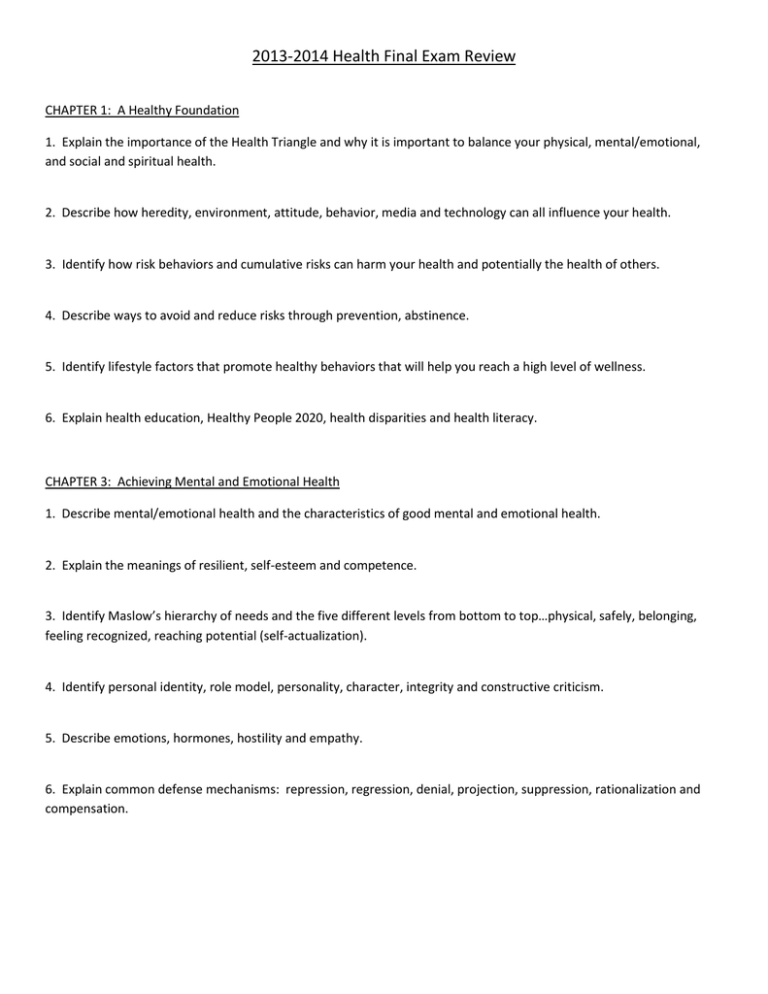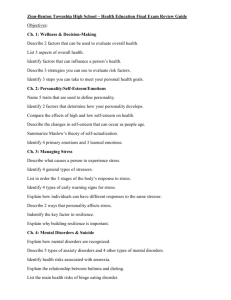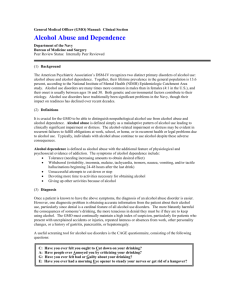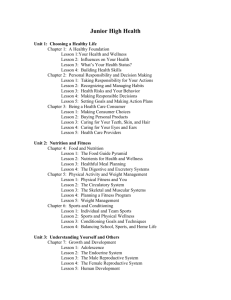Health Final Exam Study Guide
advertisement

2013-2014 Health Final Exam Review CHAPTER 1: A Healthy Foundation 1. Explain the importance of the Health Triangle and why it is important to balance your physical, mental/emotional, and social and spiritual health. 2. Describe how heredity, environment, attitude, behavior, media and technology can all influence your health. 3. Identify how risk behaviors and cumulative risks can harm your health and potentially the health of others. 4. Describe ways to avoid and reduce risks through prevention, abstinence. 5. Identify lifestyle factors that promote healthy behaviors that will help you reach a high level of wellness. 6. Explain health education, Healthy People 2020, health disparities and health literacy. CHAPTER 3: Achieving Mental and Emotional Health 1. Describe mental/emotional health and the characteristics of good mental and emotional health. 2. Explain the meanings of resilient, self-esteem and competence. 3. Identify Maslow’s hierarchy of needs and the five different levels from bottom to top…physical, safely, belonging, feeling recognized, reaching potential (self-actualization). 4. Identify personal identity, role model, personality, character, integrity and constructive criticism. 5. Describe emotions, hormones, hostility and empathy. 6. Explain common defense mechanisms: repression, regression, denial, projection, suppression, rationalization and compensation. CHAPTER 9: Resolving Conflicts and Preventing Violence 1. Describe conflict, interpersonal conflicts, how conflicts might escalate and ways to keep conflicts from escalating. 2. Explain ways to deal with conflict through compromise, negotiation, mediation, confidentiality and peer mediation. 3. Describe violence and types of violence: assault, random violence, homicide. 4. Explain sexual violence, sexual assault and rape. 5. Describe abuse in relationships: physical abuse, emotional abuse, verbal abuse, sexual abuse, stalking and date rape. CHAPTERS 16 and 17: Endocrine and Reproductive Health and The Beginning of the Life Cycle 1. Explain the function of the major female reproductive organs: eggs, ovaries, uterus, vagina, cervix, and fallopian tubes. 2. Understand the Menstruation cycle, menstrual cramps, premenstrual syndrome (PMS) and toxic shock syndrome (TSS). 3. Explain infertility and other female disorders: endometriosis, sexually transmitted diseases, vaginitis, ovarian cysts and associated cancers: cervical, uterine, and ovarian cancers. 4. Define the purpose of the major male reproductive organs: testicles, scrotum 5. Identify problems which may occur with the male reproductive system: Inguinal Hernia, sterility, testicular cancer and prostate problems and cancer. 6. Identify ways to maintain reproductive health for both males and females. CHAPTER 5: Mental and Emotional Problems 1. Explain anxiety, depression, apathy and warning signs for depression. 2. Define mental disorder, stigma, and the variety of anxiety disorders: phobia, obsessive-compulsive disorder, panic disorder, post-traumatic stress disorder (PTSD) and generalized anxiety disorder. 3. Identify and explain impulse control disorders: eating disorders, mood disorder, conduct disorder, schizophrenia and personality disorders. 4. Explain suicide prevention risk factors: alienation, suicide, cluster suicides. 5. Identify warning signs of suicide and ways you can help or where you can get help. 6. Know the differences between the mental health professionals: counselor, school psychologist, psychiatrist, neurologist, clinical psychologist and Psychiatric social workers. 7. Know about the different mental health treatment methods: psychotherapy, behavior therapy, cognitive therapy, family therapy, group therapy and drug therapy. CHAPTER 4: Managing Stress and Coping with Loss 1. Explain positive and negative stress, perception, stressor, psychosomatic response. 2. Explain how stressors activate the nervous system and specific hormones: Alarm phase, Resistance phase and Fatigue phase. 3. What is chronic stress and ways to handle stress? 4. Identify the stages of grief. 5. Understand these vocabulary words: closure, coping, mourning and traumatic event. CHAPTER 10 and 11: Nutrition for Health and Managing Weight and Eating Behaviors 1. Define nutrition, nutrients, calorie, hunger and appetite. 2. Explain the types and roles of carbohydrates and their importance, including simple, complex and fiber. 3. Explain types and roles of protein and the 20 amino acids (9 essential amino acids and complete proteins). 4. Explain types and roles of fat: unsaturated, saturated, trans and cholesterol. 5. Define vitamins, minerals and osteoporosis. 6. Explain MYPyramid and what nutrient-dense foods are. 7. Know nutrition label basics like: food additives, nutritional claims (free, low, light, reduced, high, good source of and healthy. 8. Understand the information given on nutrition facts panels: serving size, servings per container, calories, nutrients, vitamins and minerals, percent daily value. 9. Explain metabolism, body mass index (BMI), overweight, obese and underweight 10. Understand body image, types of fad diets, weight cycling. 11. Define eating disorders: anorexia nervosa, bulimia nervosa, binge eating disorder. 12. Define a vegetarian and various health conditions that can be triggered: diabetes, food allergies, lactose intolerance, celiac disease, high blood pressure, high cholesterol. 13. Identify performance enhancers: anabolic steroids and energy drinks. CHAPTER 19 and 22: Medicines and Drugs and Illegal Drugs 1. Identify the role of medicines, drugs, vaccines, antibiotics, antivirals, antifungals, analgesics (pain relievers). 2. Explain reactions to medicines: side effects, additive interaction, synergistic effect, antagonistic interaction, tolerance and withdrawal. 3. Define the difference between prescription medicines and over-the-counter (OTC) medicines. 4. Explain medicine misuse, medicine abuse and drug overdose. 5. Describe substance abuse, illegal drugs, illicit drug use and addiction. 6. Define effects of marijuana, inhalants and anabolic-androgenic steroids. 7. Identify the psychoactive drugs and their effects on the central nervous system (CNS): stimulants, depressants, opiates, hallucinogens. 8. What are common “club drugs”? 9. Which drugs are stimulants and which drugs are depressants? 10. Identify and explain the effects of opiates (narcotics) and some of their common forms. CHAPTER 21 and 20: Alcohol and Tobacco 1. Explain ethanol, fermentation, intoxication and factors that influence alcohol’s effects. 2. Identify short-term and long-term effects of alcohol. 3. Define binge drinking and alcohol poisoning and their symptoms. 4. Define psychological dependence vs. physiological dependence. 5. Define alcohol abuse vs. alcoholism (alcoholic). 6. Explain blood alcohol concentration (BAC), driving under the influence (DUI), fetal alcohol syndrome (FAS). 7. Define recovery and sobriety and the three stages of alcoholism. 8. Explain the health risks of tobacco use. 9. Define nicotine and its properties. 10. Explain about the poisonous substances in tobacco smoke: carcinogen, tar, carbon monoxide. 11. Identify the harmful effects of tobacco use (short and long term effects). 12. Explain how to possibly end the tobacco addiction cycle: nicotine, withdrawal, nicotine substitutes, tobacco cessation program. 13. Identify the differences between environmental tobacco smoke (ETS), mainstream smoke and sidestream smoke. 14. Explain the health risks to nonsmokers, unborn children and infants and young children.






